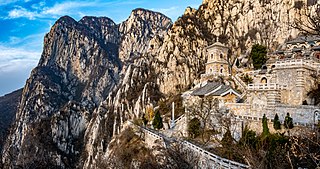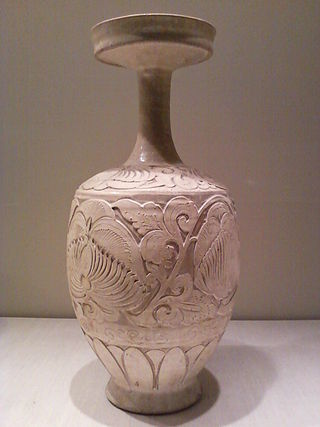
Chinese art is visual art that originated in or is practiced in China, Greater China or by Chinese artists. Art created by Chinese residing outside of China can also be considered a part of Chinese art when it is based on or draws on Chinese culture, heritage, and history. Early "Stone Age art" dates back to 10,000 BC, mostly consisting of simple pottery and sculptures. After that period, Chinese art, like Chinese history, was typically classified by the succession of ruling dynasties of Chinese emperors, most of which lasted several hundred years. The Palace Museum in Beijing and the National Palace Museum in Taipei contains extensive collections of Chinese art.
The administrative divisions of China have consisted of several levels since ancient times, due to China's large population and geographical area. The constitution of China provides for three levels of government. However in practice, there are five levels of local government; the provincial, prefecture, county, township, and village.

Henan is a landlocked province of China, in the central part of the country. Henan is often referred to as Zhongyuan or Zhongzhou (中州), which literally means "central plain" or "midland", although the name is also applied to the entirety of China proper. Henan is a birthplace of Han Chinese civilization, with over 3,200 years of recorded history and remained China's cultural, economic and political center until approximately 1,000 years ago.

Northeast China or Northeastern China is a geographical region of China. It usually corresponds specifically to the three provinces east of the Greater Khingan Range, namely Liaoning, Jilin, and Heilongjiang, but historically is meant to also encompass the four easternmost prefectures of Inner Mongolia west of the Greater Khingan. The heartland of the region is the Northeast China Plain, the largest plain in China, with an area of over 350,000 km2 (140,000 sq mi). It is separated from Russian Far East to the north by the Amur, Argun, and Ussuri Rivers; from Korea to the south by the Yalu and Tumen Rivers; and from Inner Mongolia to the west by the Greater Khingan and parts of the Xiliao River.

The history of Asian art includes a vast range of arts from various cultures, regions, and religions across the continent of Asia. The major regions of Asia include Central, East, South, Southeast, and West Asia.

Korean arts include traditions in calligraphy, music, painting and pottery, often marked by the use of natural forms, surface decoration and bold colors or sounds.

Papel picado is a traditional Mexican decorative craft made by cutting elaborate designs into sheets of tissue paper. Papel picado is considered a Mexican folk art. The designs are commonly cut from as many as 40-50 colored tissue papers stacked together and using a guide or template, a small mallet, and chisels, creating as many as fifty banners at a time. Papel picado can also be made by folding tissue paper and using small, sharp scissors. Common themes include birds, floral designs, and skeletons. Papel picados are commonly displayed for both secular and religious occasions, such as Easter, Christmas, the Day of the Dead, as well as during weddings, quinceañeras, baptisms, and christenings. In Mexico, papel picados are often incorporated into the altars (ofrendas) during the Day of the Dead and are hung throughout the streets during holidays. In the streets of Mexico, papel picados are often strung together to create a banner that can either be hung across alleyways or displayed in the home.

Straw plaiting is a method of manufacturing textiles by braiding straw and the industry that surrounds the craft of producing these straw manufactures. Straw is plaited to produce products including straw hats and ornaments, and the process is undertaken in a number of locations worldwide.

The Suzhou Museum is a museum of ancient Chinese art, paintings, calligraphy and handmade crafts in Suzhou, Jiangsu, China. It is one of the most visited museums in the world, with more than 2 million visitors in 2018. The Folk Branch of the museum is at the Bei family ancestral temple near Lion Grove Garden. The Western New Pavilion was designed by renowned architect I.M. Pei and was completed and opened in 2006.

Tourism in China is a growing industry that is becoming a significant part of the Chinese economy. The rate of tourism has expanded over the last few decades since the beginning of reform and opening-up. The emergence of a newly rich middle class and an easing of restrictions on movement by the Chinese authorities are both fueling this travel boom. China has become one of world's largest outbound tourist markets. According to Euromonitor International, economic growth and higher incomes in nearby Asian countries will help China to become the world's number one tourist destination by 2030.

María Dolores Velázquez Rivas, better known as "Lola" Cueto was a Mexican painter, printmaker, puppet designer and puppeteer. She is best known for her work in children's theater, creating sets, puppets and theatre companies performing pieces for educational purposes. Cueto took her last name from husband Germán Cueto, which whom she had two daughters, one of whom is noted playwright and puppeteer Mireya Cueto. Most of Cueto's artistic interest was related to Mexican handcrafts and folk art, either creating paintings about it or creating traditional works such as tapestries, papel picado and traditional Mexican toys.

Vase with carved peony scrolls is a Cizhou-type stoneware vase of the Northern Song dynasty, made about 1100 and now in the Asian collection of the Indianapolis Museum of Art, where it is currently on display in the Richard M. Fairbanks Gallery.
Gao Mang also known by his pen name Wulanhan, was a Chinese translator and painter who had been honored by the governments of both Russia and China.

Li or Lee is a common Chinese surname, it is the 4th name listed in the famous Hundred Family Surnames. Li is one of the most common surnames in Asia, shared by 92.76 million people in China, and more than 100 million in Asia. It is the second-most common surname in China as of 2018, the second-most common surname in Hong Kong, and the 5th most common surname in Taiwan, where it is usually romanized as "Lee". The surname is pronounced as in Cantonese, Lí (poj) in Taiwanese Hokkien, but is often spelled as "Lee" in Hong Kong, Macau, Taiwan and many overseas Chinese communities. In Macau, it is also spelled as "Lei". In Indonesia it is commonly spelled as "Lie". The common Korean surname, "Lee", and the Vietnamese surname, "Lý", are both derived from Li and written with the same Chinese character (李). The character also means "plum" or "plum tree".

The Three Gorges Museum is a museum in the Yuzhong District of Chongqing, about the Three Gorges and Chongqing. It is one of the largest museums in the country.

Chinese patchwork is a traditional form of Chinese needlework which has been widely circulated in Chinese folk arts. In China, patchwork has been used for millennia.
Hu Zhiying is a contemporary Chinese avant-garde artist and art educator. He works within the areas of painting, installation, video art, and conceptual art. His artworks are displayed worldwide, and he has taught painting and calligraphy at the Guangzhou Academy of Fine Arts and South China Normal University.

Qinhuai lantern is the traditional art of Jurong City, Jiangsu Province, in China, and part of the national intangible cultural heritage of China. Qinhuai lantern, also known as "Jinling lantern" and "Nanjing lantern", is one of the representative folk arts in Nanjing. The origin of Qinhuai lantern colour can be traced back to the Eastern Wu period, it draws on the traditional Chinese paper tie, painting, calligraphy, paper cutting, shadow puppetry, embroidery, sculpture and other arts, in the production of integrated carpentry, lacquer, painting, carving, clay sculpture, knotting and many other technical means. Qinhuai has a variety of lanterns, reaching from the traditional lanterns to lotus lanterns and lion lanterns. The variety and design of lantern works represents also current events to the time of design, such as ocean-going ships, carrier rockets, urban construction, mountain and forest landscapes.















